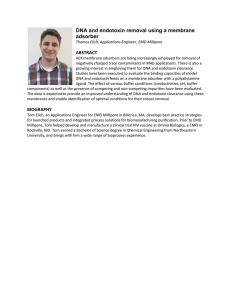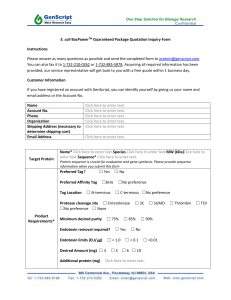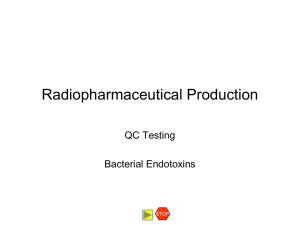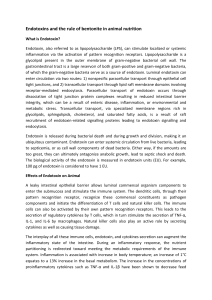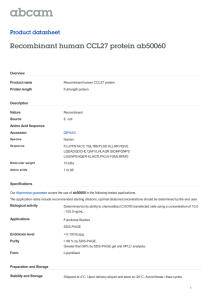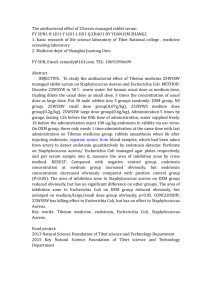ARTICLE IN PRESS
advertisement
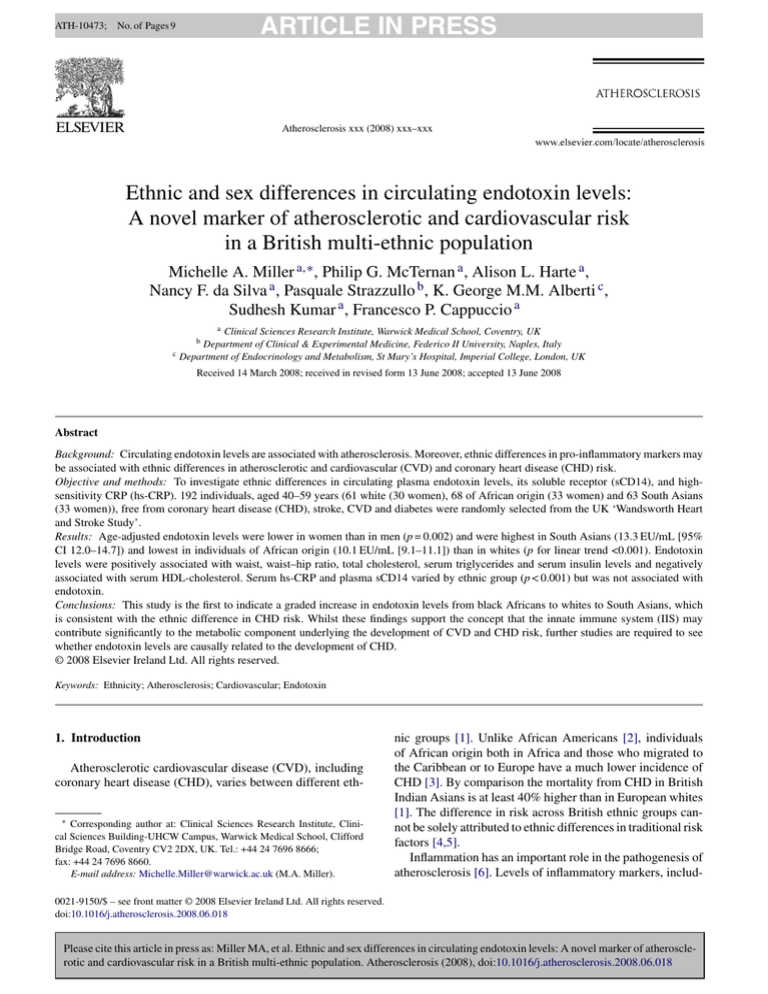
ATH-10473; ARTICLE IN PRESS No. of Pages 9 Atherosclerosis xxx (2008) xxx–xxx Ethnic and sex differences in circulating endotoxin levels: A novel marker of atherosclerotic and cardiovascular risk in a British multi-ethnic population Michelle A. Miller a,∗ , Philip G. McTernan a , Alison L. Harte a , Nancy F. da Silva a , Pasquale Strazzullo b , K. George M.M. Alberti c , Sudhesh Kumar a , Francesco P. Cappuccio a a Clinical Sciences Research Institute, Warwick Medical School, Coventry, UK Department of Clinical & Experimental Medicine, Federico II University, Naples, Italy Department of Endocrinology and Metabolism, St Mary’s Hospital, Imperial College, London, UK b c Received 14 March 2008; received in revised form 13 June 2008; accepted 13 June 2008 Abstract Background: Circulating endotoxin levels are associated with atherosclerosis. Moreover, ethnic differences in pro-inflammatory markers may be associated with ethnic differences in atherosclerotic and cardiovascular (CVD) and coronary heart disease (CHD) risk. Objective and methods: To investigate ethnic differences in circulating plasma endotoxin levels, its soluble receptor (sCD14), and highsensitivity CRP (hs-CRP). 192 individuals, aged 40–59 years (61 white (30 women), 68 of African origin (33 women) and 63 South Asians (33 women)), free from coronary heart disease (CHD), stroke, CVD and diabetes were randomly selected from the UK ‘Wandsworth Heart and Stroke Study’. Results: Age-adjusted endotoxin levels were lower in women than in men (p = 0.002) and were highest in South Asians (13.3 EU/mL [95% CI 12.0–14.7]) and lowest in individuals of African origin (10.1 EU/mL [9.1–11.1]) than in whites (p for linear trend <0.001). Endotoxin levels were positively associated with waist, waist–hip ratio, total cholesterol, serum triglycerides and serum insulin levels and negatively associated with serum HDL-cholesterol. Serum hs-CRP and plasma sCD14 varied by ethnic group (p < 0.001) but was not associated with endotoxin. Conclusions: This study is the first to indicate a graded increase in endotoxin levels from black Africans to whites to South Asians, which is consistent with the ethnic difference in CHD risk. Whilst these findings support the concept that the innate immune system (IIS) may contribute significantly to the metabolic component underlying the development of CVD and CHD risk, further studies are required to see whether endotoxin levels are causally related to the development of CHD. © 2008 Elsevier Ireland Ltd. All rights reserved. Keywords: Ethnicity; Atherosclerosis; Cardiovascular; Endotoxin 1. Introduction Atherosclerotic cardiovascular disease (CVD), including coronary heart disease (CHD), varies between different eth∗ Corresponding author at: Clinical Sciences Research Institute, Clinical Sciences Building-UHCW Campus, Warwick Medical School, Clifford Bridge Road, Coventry CV2 2DX, UK. Tel.: +44 24 7696 8666; fax: +44 24 7696 8660. E-mail address: Michelle.Miller@warwick.ac.uk (M.A. Miller). nic groups [1]. Unlike African Americans [2], individuals of African origin both in Africa and those who migrated to the Caribbean or to Europe have a much lower incidence of CHD [3]. By comparison the mortality from CHD in British Indian Asians is at least 40% higher than in European whites [1]. The difference in risk across British ethnic groups cannot be solely attributed to ethnic differences in traditional risk factors [4,5]. Inflammation has an important role in the pathogenesis of atherosclerosis [6]. Levels of inflammatory markers, includ- 0021-9150/$ – see front matter © 2008 Elsevier Ireland Ltd. All rights reserved. doi:10.1016/j.atherosclerosis.2008.06.018 Please cite this article in press as: Miller MA, et al. Ethnic and sex differences in circulating endotoxin levels: A novel marker of atherosclerotic and cardiovascular risk in a British multi-ethnic population. Atherosclerosis (2008), doi:10.1016/j.atherosclerosis.2008.06.018 ATH-10473; No. of Pages 9 2 ARTICLE IN PRESS M.A. Miller et al. / Atherosclerosis xxx (2008) xxx–xxx ing hs-CRP, are increased in atherosclerotic vascular disease in whites [7–9] and are high in South Asian individuals [6]; whereas certain cellular adhesion molecules are lower in individuals of African origin [6,10]. Whilst adhesion molecules levels are related to serum lipid levels [10], blood pressure [6] and measures of the metabolic syndrome [11], which vary by ethnic group, none of the inflammatory markers studied so far have shown any graded relationship by ethnic group which would be consistent with their CHD risk. Sub-clinical inflammation mediated through increased cytokine levels in obesity and CVD may occur through activation of both the acquired immune system (AIS) and the innate immune system (IIS) [12], which represents the first site of defence against infection. In vitro work has examined the effect of the IIS with the use of the antigen lipopolysaccharide (LPS), which represents the outer cell wall membrane of gram-negative bacteria, also referred to as endotoxin. LPS activates the IIS via toll-like receptors (TLRs), which allows a rapid reaction to infection [13]. TLRs combine with the pattern recognition molecule CD14 to form a complex (TLR4-CD14), which activates the NF-B pathway, induces the expression of inflammatory mediators and initiates an acute phase response [14]. Treatment of human subcutaneous adipocytes with LPS leads to a significant increase in TNF-␣ and IL-6 secretion [15]. An acute LPS stimulus elicits a response in the host by increasing triglyceride-rich lipoproteins in the liver and by inhibiting lipoprotein lipase leading to lipeamia [16]. However, plasma lipoproteins are capable of LPS sequestration and triglyceride-rich lipoproteins may be part of [17] and attenuate the host’s response to infection [16]. Interestingly, a high-fat meal induces low-grade endotoxemia [18] and levels of endotoxin have been associated with a threefold risk of atherosclerosis [19]. The objective of the present paper was to establish whether ethnic differences in endotoxin exist and whether these are consistent with known ethnic differences in atherosclerotic and cardiovascular risk. 2. Methods 2.1. Subjects We performed a nested study of randomly selected ageand sex-matched individuals from the Wandsworth Heart & Stroke Study (WHSS), a population-based cross-sectional study of men and women, aged 40–59 years, from three different ethnic groups [4,5]. We excluded subjects on hypertension or lipid lowering medications or taking the oral contraceptive pill or hormone replacement therapy and those with diabetes, previous medical history of ischemic heart disease or stroke. The sample size was calculated to have a power of ≥90% to detect a significant difference (p < 0.05) in circulating levels of endotoxin between groups (n = 30) of 3.6 EU/mL [S.D. 1.9]. Of the 193 individuals studied, 62 were white (30 women), 68 of black African origin (33 women) and 63 of South Asian origin (33 women). The investigation conforms to the principles outlined in the “Declaration of Helsinki.” The Local Ethics Committee approved the study. All participants gave their informed consent to participate. 2.2. Procedures Blood was taken between 0800 and 1200 h from seated subjects who had fasted overnight and had refrained from smoking or taking vigorous exercise. A detailed questionnaire was completed, height and weight were measured and BMI calculated (kg/m2 ). Waist and hip circumference (in cm) were taken by standardised methods and WHR calculated. Blood pressure (BP) was taken with standard methods and an automated recorder. Blood was taken from seated subjects without stasis. Biochemical measurements were performed as described previously [4,5]. This study utilises data from this previously wellcharacterised population as described above and has measured new variables as described in detail below. 2.3. Endotoxin assay Endotoxin measurements were performed, using the QCL-1000 Chromogenic Limulus Amebocyte Lysate (LAL) Endpoint Assay (Cambrex, NJ, USA), on heparinised plasma, which had been stored at −40 ◦ C and thawed at room temperature prior to analysis. Samples (in duplicate) mixed with LAL were incubated at 37 ◦ C (±1 ◦ C) for 10 min, substrate was added and the reaction stopped after another minute. In brief, the LAL contains and enzyme system that is activated by endotoxin. The activated enzymes split off para-nitro aniline from the chromogenic substrate. Endotoxin levels are determined spectrophotometrically at 405–410 nm by comparison with a standard curve. Samples were diluted 1 in 7 with LAL water using a standard curve in the range of 0–5 EU/mL. All the items used in the assay were sterilised (by autoclave or treatment with microsol). Plasma recovery of spiked endotoxin was 82.0 ± 3.3% efficient [15]. Plate-toplate variability within the same experiment was 7.4 ± 0.9%. Intra-assay coefficient of variation (CV) was 3.9 ± 0.46% and inter-assay CV 9.6% ± 0.75%. 2.4. Soluble CD14 (sCD14) sCD14, levels in heparinised plasma were analyzed by a solid phase enzyme amplified sensitivity immunoassay (R&D Systems; Minneapolis, USA). Intra-assay CV was 5.4% and inter-assay CV 6.3%. 2.5. hs-CRP assay hs-CRP was measured in thawed plasma K-EDTA (IL Coagulation Systems on ACL9000, IL, Milan, Italy): a latex Please cite this article in press as: Miller MA, et al. Ethnic and sex differences in circulating endotoxin levels: A novel marker of atherosclerotic and cardiovascular risk in a British multi-ethnic population. Atherosclerosis (2008), doi:10.1016/j.atherosclerosis.2008.06.018 ATH-10473; ARTICLE IN PRESS No. of Pages 9 M.A. Miller et al. / Atherosclerosis xxx (2008) xxx–xxx particle enhanced immunoturbidimetric assay to quantify hsCRP blood levels. Two quality controls were used in each assay (2.59 and 6.19 mg/L). 3 3. Results 3.1. Population characteristics and ethnic difference in endotoxin, hs-CRP and sCD14 levels 2.6. Statistical analysis Endotoxin levels were not normally distributed, as evaluated using the Kolmogorov–Smirnov (K–S) test, which tests the hypotheses of a normal distribution (Z = 1.81, p = 0.003). Therefore analyses were performed on natural log-transformed data, which normalised the data (K–S test: Z = 0.91, p = 0.380). Differences between groups (with described adjustments) were tested using analysis of covariance. For hs-CRP, the analyses were also performed on log transformed data as the K–S test demonstrated that the levels were not normally distributed (Z = 3.87; p < 0.001) but were normalised following log-transformation (Z = 0.66; p = 0.774). To facilitate biological interpretation, results are presented as geometric means and 95% confidence intervals (CI) for the log-transformed data. To test the hypothesis of a graded relationship between inflammatory markers and ethnicity from blacks to whites to South Asians, linear trend analysis was performed using ethnicity as a polynomial term. General linear models were used to estimate the relationship between endotoxin levels and cardiovascular risk factors adjusting for confounders. Interaction test was used to compare slopes between groups. Group characteristics are shown in Table 1. Serum triglycerides were highest in South Asians and lowest in people of African origin (p < 0.001) and, as observed in the entire WHSS cohort [4,5], there were significant ethnic differences in HDL-cholesterol (p < 0.001) and serum insulin (p < 0.001). Endotoxin levels varied by ethnic groups and by sex (Table 2). In the total group, age-adjusted endotoxin levels were higher in men than in women (p = 0.001). Furthermore, there was a significant linear trend indicating a graded increase in endotoxin levels from individuals of African origin to whites and South Asians, respectively, both in men (p = 0.021) and women (p = 0.003) (Fig. 1a). Following adjustment for age and sex, endotoxin levels still varied according to ethnicity: African origin 10.1 EU/mL (9.1–11.1), whites 10.9 EU/mL (9.8–12.1) and South Asians 13.3 EU/mL (12.0–14.7) (p for linear trend: <0.001). Endotoxin levels adjusted for ethnicity age and sex or age and sex alone did not vary between vegetarian (n = 25) and nonvegetarians (n = 145) in the total group (p = 0.24) or in the South Asian group (n = 18 vs n = 45, respectively; p = 0.37). hs-CRP levels varied by ethnicity but not sex (p = 0.097; Table 2, total group). There was a significant linear trend Table 1 Age-adjusted characteristics of 193 men and women, aged 40–59 years, of different ethnic groups living in Wandsworth, South London, 1994–1996 Body mass index (kg/m2 ) Waist (cm) WHR Systolic blood pressure (mmHg) Diastolic blood pressure (mmHg) Total cholesterol (mmol/L) Serum triglycerides (mmol/L)a HDL cholesterol (mmol/L) Serum glucose (mmol/L) Serum insulin (mU/L)a African origin (n = 68: men = 35; women = 33) White (n = 62: men = 32; women = 30) South Asian (n = 63: men = 30; women = 33) p value for heterogeneity Men Women Men Women Men Women Men 25.8 (24.7–27.0) 29.7 (27.9–31.5)† 90.0 (87.0–93.0) 88.1 (84.2–92.0)† 0.91 (0.89–0.93) 0.82 (0.79–0.85) 130.4 (124.5–136.2) 25.5 (24.4–26.7) 26.4 (24.4–28.3) 91.2 (88.0–94.2) 81.8 (77.6–85.9) 0.91 (0.89–0.93) 0.79 (0.76–0.82) 128.6 (122.5–134.7) 24.7 (23.5–26.0) 27.5 (25.7–29.4) 90.6 (87.4–93.8) 85.1 (81.1–89.0) 0.94 (0.92–0.96) 0.82 (0.79–0.85) 131.7 (125.5–138.0) 0.397 0.043 0.873 0.092 0.139 0.159 0.779 0.114 Women Men 132.6 (125.6–139.7)† 84.2 (80.9–87.6) 121.3 (113.8–128.7) 84.5 (80.9–88.0) 129.5 (122.4–136.7) 86.7 (83.1–90.3) 0.082 0.565 0.083 Women Men Women Men 86.0 (82.4–89.5)† 5.5 (5.2–5.9) 5.5 (5.2–5.8)† 0.84 (0.73–0.97)† 77.7 (73.9–81.4) 6.0 (5.6–6.4) 6.0 (5.7–6.4) 1.14 (0.98–1.33) 80.4 (76.8–84.0) 5.7 (5.4–6.1) 5.6 (5.3–5.9) 1.30 (1.11–1.53) 0.006 0.258 0.046 <0.001 Women Men Women Men Women Men Women 0.68 (0.60–0.78)† 1.3 (1.2–1.4) 1.6 (1.5–1.8) 5.0 (4.8–5.2) 4.8 (4.6–5.0) 7.1 (6.0–8.5) 8.6 (7.2–10.3) 0.93 (0.81–1.07) 1.3 (1.2–1.4) 1.7 (1.6–1.9) 4.9 (4.8–5.1) 5.0 (4.8–5.2) 6.6 (5.6–7.9) 6.7 (5.6–8.2) 1.19 (1.04–1.36)# 1.2 (1.1–1.3) 1.3 (1.2–1.5)## 5.0 (4.8–5.2) 5.2 (5.0–5.4) 10.4 (8.6–12.5)# 11.2 (9.3–13.4)## <0.001 0.192 0.001 0.879 0.008 0.002 0.001 Men and Women 0.039 0.356 0.049 0.041 <0.001 <0.001 0.085 <0.001 Results are means or percentages (95% CI). No more than two values missing from any cell. Comparison African vs whites † p < 0.05, Comparison South Asians vs whites # p < 0.05, ## p < 0.001. a Geometric means. †† p < 0.001; and Please cite this article in press as: Miller MA, et al. Ethnic and sex differences in circulating endotoxin levels: A novel marker of atherosclerotic and cardiovascular risk in a British multi-ethnic population. Atherosclerosis (2008), doi:10.1016/j.atherosclerosis.2008.06.018 ATH-10473; No. of Pages 9 4 ARTICLE IN PRESS M.A. Miller et al. / Atherosclerosis xxx (2008) xxx–xxx Table 2 Circulating inflammatory marker levels (age-adjusted) in the 192 men and women from the Wandsworth Heart and Stroke Study (WHSS) Endotoxin (Eu/mL)a hs-CRP (mg/mL)a sCD14 (ng/mL) Men Women Men Women Men Women African origin (n = 68: men = 35; women = 33) White (n = 61: men = 31; women = 30) South Asian (n = 63: men = 30; women = 33) p value for linear trend 11.1 (9.6–12.8) 9.1 (7.9–0.4) 1.05 (0.80–1.37) 1.15 (0.82–1.62) 12.5 (10.8–14.6) 9.6 (8.3–11.1) 1.1 (0.82–1.46) 1.29 (0.91–1.85) 14.2 (12.2–16.6) 12.3 (10.7–14.1) 1.65 (1.22–2.21) 2.43 (1.72–3.42) 0.021 0.003 0.027 0.003 Men and women <0.001† <0.001†† African origin (n = 52: men = 30; women = 22) White (n = 49: men = 26; women = 23) South Asian (n = 45: men = 20; women = 25) p value for linear trend 1557 (1424–1690) 1515 (1384–1645) 1698 (1555–1842) 1977 (1851–2103) 1642 (1479–1805) 1871 (1749–1994) 0.423 <0.001 Men and women ††† Results are means or percentages (95% CI). p values are for test of heterogeneity between ethnic groups by analysis of co-variance. No more than two values missing from any cell. Ethnicity by sex interaction: † F = 0.57, p = 0.567; †† F = 0.52, p = 0.597; ††† F = 3.72, p = 0.027. a Geometric means. for increasing hs-CRP from individuals of African origin to whites and South Asians in both men (p = 0.027) and women (p = 0.003), Following adjustment for age and sex, hs-CRP levels varied by ethnicity (African origin 1.10 ng/mL (0.88–1.36), whites 1.19 ng/mL (0.95–1.49) and South Asians 2.02 ng/mL (1.61–2.52); p for linear trend: <0.001; Fig. 1b). sCD14 levels varied by ethnic groups and by sex (Table 2). Age-adjusted sCD14 levels were higher in women than in men (p = 0.008; total group). Women had higher levels of sCD14 than men in the white (p = 0.012) and South Asian groups (p = 0.010) whereas they did not differ in the African group. Following adjustment for age and sex, sCD14 levels still varied according to ethnicity: African origin 1547 ng/mL (1451–1643), whites 1832 ng/mL (1734–1930) and South Asians 1768 ng/mL (1665–1871), p < 0.001, with a significant sex–ethnicity interaction (F = 3.72; p = 0.027). The linear trend for increasing sCD14 from Africans to whites and South Asians was significant in women (p < 0.001) but not men (p = 0.423) (Table 2). 3.2. Smoking The prevalence of current smoking was 29% in whites, 12% in people of African origin and 14% in South Asians. Endotoxin (p = 0.157), hs-CRP (p = 0.648) and sCD14 (p = 0.277) levels were not associated with smoking. 3.3. Correlation analyses 3.3.1. Endotoxin There was a significant association with WHR (r = 0.26; p < 0.001). There was a sex interaction in the association with BMI (men: r = 0.35; p = 0.001 vs women: r = −0.11; p = 0.290; interaction p < 0.001). For waist, the association was significant in men (r = 0.371; p < 0.001) but not in women (r = 0.22; p = 0.836). Endotoxin levels showed direct relationships with total cholesterol (r = 0.50; p < 0.01) and serum triglycerides (r = 0.78, p < 0.001; interaction with ethnicity p = 0.024). The association in each of the groups were as follows: total Fig. 1. (a) Age-adjusted circulating levels of endotoxin (and 95% CI) by ethnic group in men (square) and women (triangle) in three ethnic groups. No interaction by sex (p = 0.65). p is for linear trends for men and women and combined groups. (b) Age-adjusted circulating levels of hs-CRP (and 95% CI) by ethnic group in men (square) and women (triangle). No interaction by sex (p = 0.60). p is for linear trends for men and women combined groups. Please cite this article in press as: Miller MA, et al. Ethnic and sex differences in circulating endotoxin levels: A novel marker of atherosclerotic and cardiovascular risk in a British multi-ethnic population. Atherosclerosis (2008), doi:10.1016/j.atherosclerosis.2008.06.018 ATH-10473; ARTICLE IN PRESS No. of Pages 9 M.A. Miller et al. / Atherosclerosis xxx (2008) xxx–xxx 5 Table 3 General linear model analysis: endotoxin as a dependent variable African origin (n = 68) vs whites (n = 61) Model 1 = (Age, sex) Model 2 = (Model 1 + waist) Model 3 = (Model 2 + sCD14) Model 3a = (Model 2 + Chol) Model 3b = (Model 2 + insulin) Model 3c = (Model 2 + HDL) Model 3d = (Model 2 + Trigs) Model 4 = (Model 1 + WHR + Trigs) Model 5 = (Model 1 + BMI + Trigs) South Asian (n = 63) vs whites (n = 61) Difference (%) (95% CI) p Difference (%) (95% CI) p −7.4 −9.5 −7.7 −1.6 −9.5 −9.8 14.7 15.7 14.6 (−19.1 to 6.0) (−20.1 to 3.4) (−21.7 to 8.7) (−12.9 to 11.2) (−20.8 to 3.4) (−20.1 to 1.8) (3.5 to 27.3) (4.3 to 28.4) (3.3 to 27.3) 0.260 0.140 0.333 0.139 0.139 0.095 0.010 0.006 0.011 22.8 21.0 20.8 27.9 8.2 8.0 3.9 3.6 3.9 (4.6 to 44.2) (3.3 to 41.9) (−0.4 to 46.5) (10.6 to 48.0) (−9.2 to 29.0) (−7.3 to 25.9) (−5.2 to 13.7) (−5.4 to 13.7) (−5.2 to 13.7) 0.013 0.019 0.055 0.001 0.371 0.321 0.411 0.435 0.415 Difference in the levels of endotoxin (%) for people of African origin compared to Whites and for South Asians compared to whites. Abbreviations: Chol, total cholesterol; HDL, HDL-cholesterol; Trigs, triglycerides; WHR, waist–hip ratio; BMI, body mass index. group r = 0.78: p < 0.001; whites; r = 0.80: p < 0.001; Africans r = 0.59: p < 0.001; South Asians r = 0.87: p < 0.001. There was an inverse relationship with HDL-cholesterol (r = −0.44; p < 0.001). There was an association with fasting serum insulin (r = 0.32, p < 0.001) and hs-CRP (r = 0.22, p = 0.002). Selected individual relationships are shown in Appendix Fig. A.1a for men and in Fig. A.1b for women, separately. 3.3.2. hs-CRP There were associations between hs-CRP and all the variables of interest except total cholesterol. Except for serum glucose (p = 0.04) there were no interactions with sex and except for BMI (p = 0.03) there were no interactions with ethnicity. 3.3.3. sCD14 There were no associations between sCD14 and endotoxin or with hs-CRP and no association with the cardiovascular risk factors except with WHR (r = −0.18, p = 0.030). 3.4. General linear models Given the observed associations between endotoxin, hsCRP levels and other cardiovascular risk factors, we tested whether the observed ethnic differences in endotoxin and hs-CRP levels persisted after adjustment for these factors (Appendix Fig. A.2a and b and Tables 3 and 4). When adjusted for multiple confounders there was no difference in endotoxin levels between whites and individuals of African origin except when adjustment was made for serum triglycerides. This adjustment led to a dramatic increase in plasma endotoxin in participants of African descent (Table 2: Appendix Fig. A.2a; p = 0.010). By contrast the levels of endotoxin were higher in South Asians compared to whites (Table 3: Appendix Fig. A.2a). However, this difference disappeared after adjustment for metabolic risk factors. When adjusted for multiple confounders there was no difference in hs-CRP levels between whites and individuals of African origin (Table 4: Appendix Fig. A.2b). By contrast hs-CRP was significantly higher in South Asians compared to whites (71%, p < 0.001 adjusted for age and sex) and remained so even after adjustment for anthropomet- Table 4 General linear regression analysis: hs-CRP as a dependent variable African origin (n = 68) vs whites (n = 61) hs-CRP Model 1 = (Age, sex) Model 2 = (Model 1 + Waist) Model 3a = (Model 2 + Chol) Model 3b = (Model 2 + insulin) Model 3c = (Model 2 + HDL) Model 3d = (Model 2 + Trigs) Model 3e = (Model 2 + sCD14) Model 3f = (Model 2 + endotoxin) Model 3g = (Model 2 + sCD14 + endotoxin) Model 4 = (Model 3g (WHR not waist)) Model 5 = (Model 3g (BMI not waist)) South Asian (n = 63) vs whites (n = 61) Difference (%) (95% CI) p Difference (%) (95% CI) p −7.1 −15.2 −15.2 −15.8 −15.6 2.63 −16.3 −12.5 −13.2 −11.9 −15.7 (−31.8 to 26.3) (−36.5 to 13.2) (−37.1 to 14.4) (−37.4 to 13.2) (−30.4 to 11.9) (−24.9 to 40.2) (−39.5 to 15.7) (−34.7 to 17.0) (−37.1 to 19.7) (−36.6 to 22.3) (−39.0 to 16.4) 0.634 0.262 0.278 0.253 0.236 0.870 0.279 0.363 0.384 0.444 0.295 71.4 57.0 61.1 51.6 49.0 48.7 71.1 49.9 58.7 50.7 68.0 (23.9 to 137.0) (20.2 to 104.8) (23.1 to 110.9) (11.9 to 105.4) (12.6 to 97.0) (13.7 to 94.4) (26.4 to 131.6) (14.4 to 86.4) (17.8 to 114.0) (9 to 108.5) (25.9 to 124.3) 0.001 0.001 0.001 0.008 0.006 0.004 0.001 0.004 0.003 0.014 0.001 Difference in the levels of hs-CRP (%) for people of African origin compared to whites and for South Asians compared to whites. Abbreviations: Chol, total cholesterol; HDL, HDL-cholesterol; Trigs, triglycerides; WHR, waist–hip ratio; BMI, body mass index. Please cite this article in press as: Miller MA, et al. Ethnic and sex differences in circulating endotoxin levels: A novel marker of atherosclerotic and cardiovascular risk in a British multi-ethnic population. Atherosclerosis (2008), doi:10.1016/j.atherosclerosis.2008.06.018 ATH-10473; No. of Pages 9 6 ARTICLE IN PRESS M.A. Miller et al. / Atherosclerosis xxx (2008) xxx–xxx ric measures, metabolic variables or for endotoxin and sCD14 (Table 4: Appendix Fig. A.2b). 4. Discussion This study clearly shows that circulating endotoxin levels are associated with expected differences in atherosclerotic vascular disease risk; that is endotoxin levels are higher in men than women and highest in South Asians and lowest in people of African origin. This is consistent with the graded estimated 10-year CHD risk in this cohort (from 7.0 per 1000 per year in the African individuals to 8.8 in whites to 9.2 in South Asians) [20]. The greatest difference in endotoxin levels appeared to be between whites and South Asians but the linear trends across all groups were significant in both men and women (Table 2) and whilst in South Asians the increased levels are attenuated following adjustment for metabolic variables, in individuals of African origin an adjustment for the low level of triglyceride results in higher endotoxin levels (Table 3: Appendix Fig. A.2a). The generation of an inflammatory response to LPS depends upon the complex interaction between specific proteins and receptors but circulating endotoxin levels were not associated with sCD14. hs-CRP levels also showed a graded increase from black Africans to whites to South Asians as shown by a highly significant linear trend. hs-CRP was associated with endotoxin in men and women and in each ethnic group and adjustment for endotoxin levels slightly attenuated the difference in hs-CRP between whites and South Asians (Table 4). In South Asians, the association between endotoxin levels and cardiovascular risk factors, including central adiposity, serum lipids and insulin levels, suggests a consistent pattern with markers of the metabolic syndrome. However, the determinants of endotoxin levels in individuals of African origin are very different. During hyperinsulinemia Kupffer cells in the liver show a decreased functionality [21]. This may contribute to a decreased clearance of LPS adsorbed from the GI tract and an increase in circulating LPS and insulin levels [22]. In rats, inhibition of the action of Kuppfer cells can lead to increased systemic insulin secretion in response to glucose stimulation, which may lead to insulin resistance [23]. As such, it would be expected that the ethnic difference in vascular and diabetic risk may differentially mediate the pathogenesis related to endotoxin levels associated with inflammatory cytokines. However, whilst LPS levels were highest in South Asian individuals who have the greatest insulin resistance and central adiposity; individuals of African origin who have greater insulin levels than whites did not have a concomitant increase in endotoxin levels. LPS is associated with hs-CRP levels and the secretion of this and other pro-inflammatory cytokines may be modulated by serum lipid levels [24]. Hence, the adverse lipid profile in South Asians may further exacerbate the effect of LPS in these individuals. Studies have suggested that HDL may bind LPS in the presence of its receptor (sCD14) and lipopolysaccharide binding protein (LBP) [25,26]. This would effectively neutralise the potential harmful action of LPS and previous studies have shown that chylomicrons are correlated with sCD14 [27]. This may provide a mechanism for clearance of bacterial antigens [28]. However, whilst in South Asians adjustment for low HDL-cholesterol attenuates the observed increase in endotoxin levels, in individuals of African origin adjustment for high HDL-cholesterol does not influence endotoxin levels. Furthermore, adjustment for sCD14 had no appreciable effect in people of African origin. In this study sCD14 levels were not related to endotoxin or hs-CRP. This suggests that either the pathway is not dependent on the circulating level of sCD14 or that signalling is occurring through a different receptor complex. Adjustment for low triglyceride levels in individuals of African origin has a major effect and leads to a significant increase in levels from −9.5% to 14.7% compared to whites (Table 3). In South Asians, insulin and HDL-cholesterol appear to be equally important determinants of endotoxin levels and triglycerides appear to have the greatest effect. In rats, neonatal endotoxin challenge contributes to glucose homeostasis, insulin action and susceptibility to diabetes in later life [29] therefore the study of early life course events on subsequent endotoxin levels in man may be warranted. Our findings highlight sex differences in endotoxin levels which are consistent with sex differences in vascular risk. Our findings are in part consistent with the recent comprehensive animal study which has shown that metabolic endotoxemia may initiate obesity and insulin resistance in rats [30] and the results from the prospective Bruneck Study, which used the same LAL assay, indicated that increased levels of endotoxin were associated with an increased atherosclerotic risk [19]. 5. Limitations of the study The LAL assay was developed for in vitro diagnostic use only. It is not recommended as an aid for the diagnosis of human disease. Further studies are required to determine whether endotoxin, determined by this method, is able to predict the onset of CHD and whether this assay may be of use for the diagnosis and prevention. This study was crosssectional and although we have studied different parts of the proposed pathway it is still difficult to imply direct causeeffect relationships from the reported associations. Although the number of subjects studied is relatively small it is adequately powered for comparison of differences by ethnic group. More detailed sub-group analysis would need to be performed in a larger group. 6. Summary and implications from this study This study contributes to the body of evidence supporting the concept that innate immune pathways may be important in Please cite this article in press as: Miller MA, et al. Ethnic and sex differences in circulating endotoxin levels: A novel marker of atherosclerotic and cardiovascular risk in a British multi-ethnic population. Atherosclerosis (2008), doi:10.1016/j.atherosclerosis.2008.06.018 ATH-10473; No. of Pages 9 ARTICLE IN PRESS M.A. Miller et al. / Atherosclerosis xxx (2008) xxx–xxx 7 Fig. A.1. (a) Relationships between circulating plasma endotoxin, levels and metabolic variables in men (blue circles, whites; red circles, African origin; green circles, South Asians). (b) Relationships between circulating plasma endotoxin levels and metabolic variables in women (blue circles, whites; red circles, African origin; green circles, South Asians). Please cite this article in press as: Miller MA, et al. Ethnic and sex differences in circulating endotoxin levels: A novel marker of atherosclerotic and cardiovascular risk in a British multi-ethnic population. Atherosclerosis (2008), doi:10.1016/j.atherosclerosis.2008.06.018 ATH-10473; No. of Pages 9 8 ARTICLE IN PRESS M.A. Miller et al. / Atherosclerosis xxx (2008) xxx–xxx Fig. A.2. (a) Multiple regression of endotoxin as dependent variables. Percentage difference in endotoxin in African origin and South Asian individuals compared to whites. (b) Multiple regression of hs-CRP as dependent variables. Percentage difference in hs-CRP in African origin and South Asian individuals compared to whites. the development of atherosclerotic risk. Furthermore, ethnic differences in these inflammatory processes appear in part to be related to differences in endotoxin levels. Further prospective studies in different ethnic groups are required to confirm whether changes in endotoxin levels precede the development of atherosclerotic vascular disease. Activation of the IIS, as well as the AIS, may be important in disease development and may provide new therapeutic targets for the prevention and treatment of these diseases. Acknowledgements A list of the WHSS study group is given elsewhere [5]. Funding support for this work was from the former Wandsworth and South Thames Regional Health Authorities; NHS R&D Directorate; former British Diabetic Association; and The Stroke Association. Appendix A Relationships between circulating plasma endotoxin levels and selected metabolic variables are shown in men and women (Figs. A.1a and b). Multiple regression of endotoxin and hs-CRP are shown (Figs A.2a and b). References [1] Balarajan R. Ethnicity and variations in the nation’s health. Health Trends 1995–96;27:114–119. [2] Cooper RS, Ghali JK. Coronary heart disease: black–white differences. Cardiovasc Clin 1991;21:205–25. [3] Cappuccio FP. Ethnicity and cardiovascular risk: variations in people of African ancestry and South Asian origin. J Hum Hypertens 1997;11:571–6. [4] Cappuccio FP, Cook DG, Atkinson RW, Strazzullo P. Prevalence, detection, and management of cardiovascular risk factors in different ethnic groups in south London. Heart 1997;78:555–63. Please cite this article in press as: Miller MA, et al. Ethnic and sex differences in circulating endotoxin levels: A novel marker of atherosclerotic and cardiovascular risk in a British multi-ethnic population. Atherosclerosis (2008), doi:10.1016/j.atherosclerosis.2008.06.018 ATH-10473; No. of Pages 9 ARTICLE IN PRESS M.A. Miller et al. / Atherosclerosis xxx (2008) xxx–xxx [5] Cappuccio FP, Cook DG, Atkinson RW, Wicks PD. The Wandsworth Heart & Stroke Study. A population-based survey of cardiovascular risk factors in different ethnic groups. Methods and baseline findings. Nutr Metab Cacrdiovasc Dis 1998;8:371–85. [6] Miller MA, Cappuccio FP. Ethnicity and inflammatory pathways— implications for vascular disease. Vasc Risk Therap Interv Curr Med Chem 2007;14(13):1409–25. Review. [7] Ridker PM, Hennekens CH, Buring JE, Rifai N. C-reactive protein and other markers of inflammation in the prediction of cardiovascular disease in women. N Engl J Med 2000;342:836–43. [8] Koh KK, Han SH, Quon MJ. Inflammatory markers and the metabolic syndrome: insights from therapeutic interventions. J Am Coll Cardiol 2005;46:1978–85. [9] Hwang SJ, Ballantyne CM, Sharrett AR, et al. Circulating adhesion molecules VCAM-1, ICAM-1, and E-selectin in carotid atherosclerosis and incident coronary heart disease cases: the Atherosclerosis Risk in Communities (ARIC) study. Circulation 1997;96:4219–25. [10] Miller MA, Sagnella GA, Kerry SM, Strazzullo P, Cook DG, Cappuccio FP. Ethnic differences in circulating soluble adhesion molecules. The Wandsworth heart and stroke study. Clin Sci (Lond) 2003;104:591–8. [11] Miller MA, Cappuccio FP. Cellular adhesion molecules and their relationship with measures of obesity and metabolic syndrome in a multiethnic population. Int J Obes 2006;30:1176–82. [12] Medzhitov R, Janeway Jr CA. An ancient system of host defense. Curr Opin Immunol 1998;10:12–5. [13] Kaisho T, Akira S. Toll-like receptors as adjuvant receptors (68). Biochim Biophys Acta 2002;1589:1–13. [14] Muzio M, Polentarutti N, Bosisio D, Manoj Kumar PP, Mantovani A. Toll-like receptor family and signalling pathway. Biochem Soc Trans 2000;28:563–6. [15] Creely SJ, McTernan PG, Kusminski CM, et al. Lipopolysaccharide activates an innate immune system response in human adipose tissue in obesity and type 2 diabetes. Am J Physiol Endocrinol Metab 2007;292:E740–7. [16] Barcia AM, Harris HW. Triglyceride-rich lipoproteins as agents of innate immunity. Clin Infect Dis 2005;41(Suppl. 7):S498–503. [17] Levels JH, Marquart JA, Abraham PR, et al. Lipopolysaccharide is transferred from high-density to low-density lipoproteins by lipopolysaccharide-binding protein and phospholipid transfer protein. Infect Immun 2005;73:2321–6. [18] Erridge C, Attina T, Spickett CM, Webb DJ. A high-fat meal induces low-grade endotoxemia: evidence of a novel mechanism of postprandial inflammation. Am J Clin Nutr 2007;86(5):1286–92. 9 [19] Wiedermann CJ, Kiechl S, Dunzendorfer S, et al. Association of endotoxemia with carotid atherosclerosis and cardiovascular disease: prospective results from the Bruneck Study. J Am Coll Cardiol 1999;34(7):1975–81. [20] Cappuccio FP, Oakeshott P, Strazzullo P, Kerry SM. Application of Framingham risk estimates to ethnic minorities in United Kingdom and implications for primary prevention of heart disease in general practice: cross sectional population based study. BMJ 2002 Nov;325: 1271–4. [21] Walrand S, Guillet C, Boirie Y, Vasson MP. In vivo evidences that insulin regulates human polymorphonuclear neutrophil functions. J Leukoc Biol 2004;76:1104–10. [22] Cornell RP. Mechanisms of acute hyperinsulinemia after Kupffer cell phagocytosis. Am J Physiol 1980;238:E276–83. [23] Cornell RP. Endogenous gut-derived bacterial endotoxin tonically primes pancreatic secretion of insulin in normal rats. Diabetes 1985;34:1253–9. [24] Rovers C, Netea MG, de Bont N, et al. LPS-induced cytokine production and expression of beta2-integrins and CD14 by peripheral blood mononuclear cells of patients with homozygous familial hypercholesterolemia. Atherosclerosis 1998;141: 99–105. [25] Wurfel MM, Hailman E, Wright SD. Soluble CD14 acts as a shuttle in the neutralization of lipopolysaccharide (LPS) by LPSbinding protein and reconstituted high density lipoprotein. J Exp Med 1995;181:1743–54. [26] Parker TS, Levine DM, Chang JC, Laxer J, Coffin CC, Rubin AL. Reconstituted high-density lipoprotein neutralizes gram-negative bacterial lipopolysaccharides in human whole blood. Infect Immun 1995;63:253–8. [27] Fernandez-Real JM, Broch M, Richart C, Vendrell J, Lopez-Bermejo A, Ricart W. CD14 monocyte receptor, involved in the inflammatory cascade, and insulin sensitivity. J Clin Endocrinol Metab 2003;88: 1780–4. [28] Harris HW, Grunfeld C, Feingold KR, et al. Chylomicrons alter the fate of endotoxin, decreasing tumor necrosis factor release and preventing death. J Clin Invest 1993;91:1028–34. [29] Walker FR, Owens J, Ali S, Hodgson DM. Individual differences in glucose homeostasis: do our early life interactions with bacteria matter? Brain Behav Immun 2006;20:401–9. [30] Cani PD, Amar J, Iglesias MA, et al. Metabolic endotoxemia initiates obesity and insulin resistance. Diabetes 2007;56(7): 1761–72. Please cite this article in press as: Miller MA, et al. Ethnic and sex differences in circulating endotoxin levels: A novel marker of atherosclerotic and cardiovascular risk in a British multi-ethnic population. Atherosclerosis (2008), doi:10.1016/j.atherosclerosis.2008.06.018
